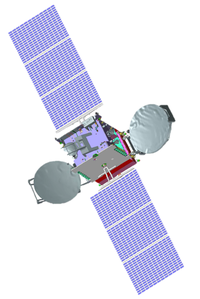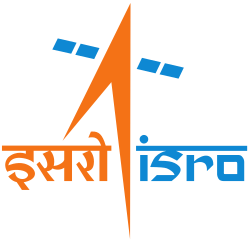GSAT-30
| GSAT-30 | |
|---|---|
| Renderanimation des Satelliten | |
| Betreiber | ISRO |
| Startdatum | 16. Januar 2020, 21:05 UTC |
| Trägerrakete | Ariane 5 ECA+ (VA251) |
| Startplatz | Centre Spatial Guyanais, ELA-3 |
| COSPAR‑ID | 2020-005A |
| Startmasse | 3357 kg |
| Hersteller | |
| Satellitenbus | I-3K-Bus |
| Stabilisation | Dreiachsenstabilisation |
| Lebensdauer | > 15 Jahre (geplant) |
| Wiedergabeinformation | |
| Transponder | je 12 im C- und Ku-Band |
| Sonstiges | |
| Elektrische Leistung | 6 kW |
| Position | |
| Aktuelle Position | 83° Ost |
| Liste geostationärer Satelliten | |
GSAT-30 ist die Bezeichnung eines indischen Kommunikationssatelliten. Er ist der insgesamt 24. Satellit der GSAT-Reihe und wird von der indischen Weltraumbehörde ISRO betrieben.
Technische Daten
Der Satellit basiert auf dem I-3K-Satellitenbus der ISRO. Er ist mit jeweils zwölf C- und Ku-Band-Transpondern ausgerüstet und versorgt Asien und Australien mit Satellitenfernsehen und VSAT-Dienstleistungen. Des Weiteren besitzt er zwei große Solarpanele und Batterien, welche zusammen etwa sechs Kilowatt Strom erzeugen. Er wog beim Start etwa 3350 kg und besitzt eine geplante Lebensdauer von mehr als 15 Jahren.
Missionsverlauf
GSAT-30 wurde am 16. Januar 2020 mit einer Ariane-5-Trägerrakete vom Raumfahrtzentrum Guayana zusammen mit Eutelsat Konnect ins All gebracht. Als er seine geostationäre Position bei 83° Ost[1] erreichte, löste er dort seinen Vorgängersatelliten Insat-4A ab und wurde in Betrieb genommen.[2]
Galerie
- Präsentationsvideo der VA251-Mission mit GSAT-30
- Präsentationsvideo des Satelliten (Arianespace)
- Der Satellit in zusammengefaltetem Zustand
- Ausklapptest der Solarpanele
- Der Satellit vor dem Start
Weblinks
- GSAT-30 auf der Homepage des Betreibers (englisch)
Einzelnachweise
Auf dieser Seite verwendete Medien
(c) Indian Space Research Organisation (GODL-India)
Render of GSAT-30 spacecraft in stowed configuration with solar panels and reflectors not extended.
(c) Indian Space Research Organisation (GODL-India)
GSAT-30 in cleanroom before launch on Ariane-5 VA251.
Logo of Indian Space Research Organisation.
(c) Indian Space Research Organisation (GODL-India)
Render of GSAT-30 spacecraft in deployed configuration with solar panels and reflectors extended.
(c) arianespace, CC BY 3.0
For its initial flight of 2020, Arianespace will orbit two telecommunications satellites using an Ariane 5 launch vehicle from the Guiana Space Center: EUTELSAT KONNECT for the operator Eutelsat; and GSAT-30 for the Indian Space Research Organization (ISRO).
Arianespace will confirm its leadership in the geostationary launch services market segment through this 107th Ariane 5 mission, to be performed as the company celebrates 40 years since its creation.
Flight VA251 will be performed from Ariane Launch Complex No. 3 (ELA 3) in Kourou, French Guiana.
Liftoff is planned on Thursday, January 16, 2020 as early as possible within the following launch window:
- Between 4:05 p.m. and 6:00 p.m. Washington, D.C. time - Between 6:05 p.m. and 8:00 p.m. Kourou, French Guiana time - Between 21:05 and 23:00 Universal time (UTC) - Between 10:05 p.m. and 12:00 a.m. Paris time, in the night of January 16 to 17 - Between 2:35 a.m. and 4:30 a.m. New Delhi time, in the morning of January 17
For further information, download the Flight VA251 Launch Kit by clicking here: http://www.arianespace.com/press-kits/(c) arianespace, CC BY 3.0
For its initial flight of 2020, Arianespace will orbit two telecommunications satellites using an Ariane 5 launch vehicle from the Guiana Space Center: EUTELSAT KONNECT for the operator Eutelsat; and GSAT-30 for the Indian Space Research Organization (ISRO).
Arianespace will confirm its leadership in the geostationary launch services market segment through this 107th Ariane 5 mission, to be performed as the company celebrates 40 years since its creation.
Flight VA251 will be performed from Ariane Launch Complex No. 3 (ELA 3) in Kourou, French Guiana.
Liftoff is planned on Thursday, January 16, 2020 as early as possible within the following launch window:
- Between 4:05 p.m. and 6:00 p.m. Washington, D.C. time - Between 6:05 p.m. and 8:00 p.m. Kourou, French Guiana time - Between 21:05 and 23:00 Universal time (UTC) - Between 10:05 p.m. and 12:00 a.m. Paris time, in the night of January 16 to 17 - Between 2:35 a.m. and 4:30 a.m. New Delhi time, in the morning of January 17
For further information, download the Flight VA251 Launch Kit by clicking here: http://www.arianespace.com/press-kits/(c) Indian Space Research Organisation (GODL-India)
GSAT-30 undergoing tests in clearoom.










